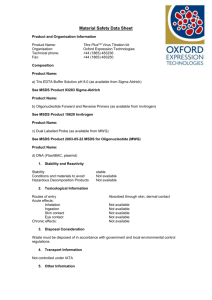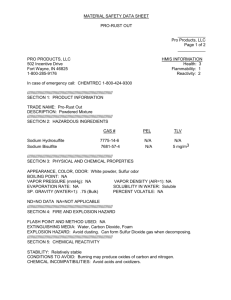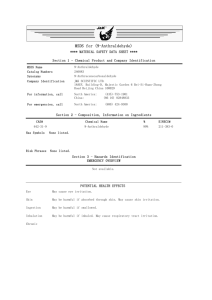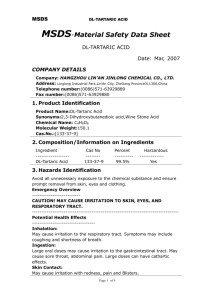Spot Shot Part 1 Material Safety Data Sheet Updated: 11/04
advertisement
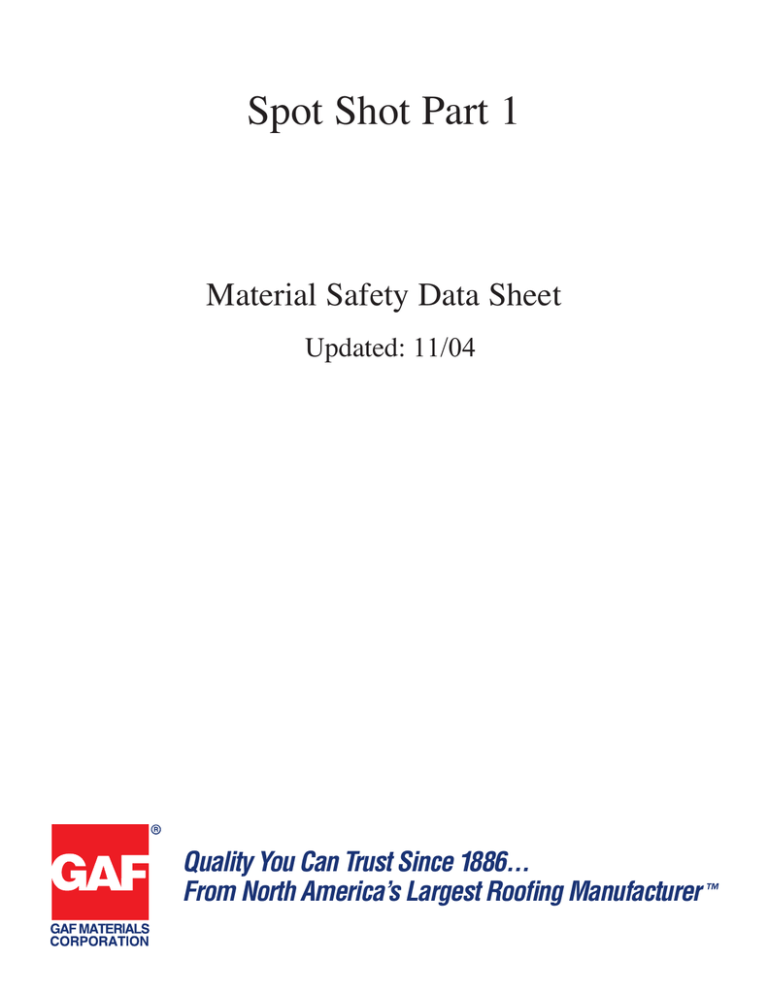
Spot Shot Part 1 Material Safety Data Sheet Updated: 11/04 Quality You Can Trust Since 1886... From North America’s Largest Roofing Manufactur Quality You Can Trust Since 1886... From North America’s Largest Roofing Manufacturer ™ SpotShot Part 1 MSDS Number: foam00 Page 1 November 30, 2004 ________________________________________ MATERIAL SAFETY DATA SHEET 1. CHEMICAL PRODUCT AND COMPANY IDENTIFICATION ______________________ Product Identification Product Name: SpotShot Part 1 Product Number: cartridges Chemical Name: Polymeric MDI Chemical Family: POLYMETHYLENE POLYPHENYLISOCYANATE CAS Number: Mixture ______________________ Company Identification ERSystems- Elastomeric Roofing Systems, Inc. 6900 Bleck Dr Rockford, MN 55373 USA 1-800-403-7747 (For product information) 1-800-535-5053 Infotrac (For emergencies) SPECIAL NOTES: Part A of two part polyurethane system. polyphenylisocyanate. 2. Polymethylene COMPOSITION/INFORMATION ON INGREDIENTS 100.0% SpotShot Part 1 CONTAINING: HAZARDOUS AND/OR REGULATED COMPONENTS Chemical Name _____________ 4,4'-DIPHENYLMETHANE DIISOCYANATE NON-HAZARDOUS COMPONENTS Chemical Name _____________ POLYMERIC MDI MDI MIXED ISOMERS (See Section 8 for exposure guidelines) (See Section 15 for regulatory information) ________ Amount 42.0 % __________ CAS Number 101-68-8 ________ Amount < 55.0 % < 5.0 % __________ CAS Number 9016-87-9 26447-40-5 SpotShot Part 1 Page 2 MSDS Number: foam00 November 30, 2004 ____________________________________________________________________________________________________ (section 2 continued) HAZARDS DISCLOSURE This product contains hazardous materials as defined by the OSHA Hazard Communication Standard 29 CFR 1910.1200. As defined under Sara 311 and 312, this product contains materials that are hazards. 3. HAZARDS IDENTIFICATION ***************** EMERGENCY OVERVIEW ***************** * * * CAUTION * * * * Prolonged or repeated contact may cause skin or eye * * irritation. May be harmful if swallowed. Long * * term exposure to isocyanates has been reported to * * cause lung damage, including reduced lung function * * which may be permanent. * * * ********************************************************** HMIS Rating - Health: Flammability: Reactivity: Personal Protection Index: 2 1 1 S POTENTIAL HEALTH EFFECTS EYE: Contact may cause eye irritation. of the eye surface). May result in corneal opacity (clouding SKIN: Causes skin burns, irritation, and possible allergic reaction. In those who have developed skin sensitization, these symptoms can develop as a result of contact with a very small amount of the liquid material. INHALATION: Avoid breathing vapors or mists. Prolonged or excessive inhalation may cause respiratory tract irritation. May cause allergic respiratory reaction. SpotShot Part 1 Page 3 MSDS Number: foam00 November 30, 2004 ____________________________________________________________________________________________________ (section 3 continued) INGESTION: Harmful if swallowed. Can burn mouth, throat, and stomach. CHRONIC EFFECTS: Sensitized (allergic) individuals may show allergenic lung and/or skin reaction. Increased sensitivity may persist for weeks and in some extreme cases, years. Any individual diagnosed as sensitive to isocyanates must avoid all exposure. CARCINOGENICITY INFORMATION: Listed by IARC and NTP as a carcinogen. MEDICAL CONDITIONS AGRAVATED BY EXPOSURE: Individuals who are sensitized to isocyanates and those with preexisting lung disease or conditions, including non-specific bronchial hyperreactivity or asthma, must avoid all exposure to isocyanates. 4. FIRST AID MEASURES EYE CONTACT FIRST AID: After initial flushing, remove any contact lenses and continue flushing for at least 15 minutes. Get immediate medical attention. SKIN CONTACT FIRST AID: Remove contaminated clothing and shoes. Wash affected area immediately with large amounts of soap and water. Get medical attention immediately. INHALATION FIRST AID: If inhaled, remove to fresh air. If not breathing, give artificial respiration. Get immediate medical attention. INGESTION FIRST AID: If swallowed, immediately give 2 glasses of water. Do not induce vomiting. Contact a physician. Never give anything by mouth to an unconscious person. Get immediate medical attention. NOTES TO PHYSICIAN: There is no antidote to counteract the effects of MDI. Care should be supportive and treatment should be based on the judgment of the physician in response to the action of the patient. SpotShot Part 1 Page 4 MSDS Number: foam00 November 30, 2004 ____________________________________________________________________________________________________ 5. FIRE FIGHTING MEASURES FLAMMABLE PROPERTIES COC Flash Point: 220 C (428.0 F) Autoignition Temperature: N/A FLAMMABLE LIMITS IN AIR LEL: N/A UEL: N/A FLAMMABLE PROPERTIES: Full emergency equipment with self contained breathing apparatus and full protective clothing should be worn. At temperatures greater than 400 F material may polymerize causing pressure build up in closed containers. Explosive rupture is possible. Use cold water to cool containers exposed to fire. EXTINGUISHING MEDIA: Water, carbon dioxide, foam or dry powder. FIRE & EXPLOSION HAZARDS: Material will burn in a fire. FIRE FIGHTING INSTRUCTIONS: As in any fire, wear self-contained breathing apparatus pressure-demand MSHA/NIOSH (approved or equivalent) and full protective gear. MISCELLANEOUS: Reacts with water to form carbon dioxide gas, wich may create excessive pressure in containers. Reacts exothermically with polyol and alcohols. Reacts exothermically and possibly violently with acids, amines and alkaline solutions. 6. ACCIDENTAL RELEASE MEASURES SAFEGUARDS (PERSONNEL): Evacuate non-emergency personnel to a safe area. Avoid breathing vapor. Ventilate spill area. Wear safety goggles. Wear appropriate personal protective equipment. INITIAL CONTAINMENT: Contain spilled material. Absorb spills with inert material. closed containers but do not seal. Place in SpotShot Part 1 Page 5 MSDS Number: foam00 November 30, 2004 ____________________________________________________________________________________________________ (section 6 continued) LARGE SPILLS PROCEDURE: Absorb spill with inert material (e g, dry sand or earth), then place in a chemical waste container.Place in closed containers but do not seal. Neutralize spill with mixture of 90% water, 3-8% ammonia and 2-7% detergent. Add at a 10 to 1 ratio and let stand for 48 hrs allowing CO2 to escape. 7. HANDLING AND STORAGE RECOMMENDED STORAGE TEMPERATURE Minimum: 15.6 C (60.1 F) Maximum: 26.7 C (80.1 F) SHELF LIFE: (in original, sealed containers) 8 months @ 26.7 C HANDLING (PERSONNEL): Avoid contact with eyes. Avoid prolonged or repeated contact with skin. Wash hands thoroughly after handling. Do not reuse this container. HANDLING (PHYSICAL ASPECTS): Provide appropriate ventilation. Close container after each use. Keep container closed to avoid contamination. Keep out of reach of children. STORAGE PRECAUTIONS: Avoid extreme temperatures. in a cool dry place. Keep container closed when not in use. Store SPECIAL SENSITIVITY: All handling equipment should be electrically grounded. 8. EXPOSURE CONTROLS / PERSONAL PROTECTION ENGINEERING CONTROLS: Facilities storing or utilizing this material should be equipped with an eyewash facility and a safety shower. Use process enclosures, local exhaust ventilation, or other engineering controls to control airborne levels below recommended exposure limits. SpotShot Part 1 Page 6 MSDS Number: foam00 November 30, 2004 ____________________________________________________________________________________________________ (section 8 continued) EYE / FACE PROTECTION REQUIREMENTS: Wear safety glasses. A respiratory protection program that meets OSHA's 29 CFR 1910-134 and ANSI Z88-2 requirements must be followed whenever workplace conditions warrant a respirator's use. SKIN PROTECTION REQUIREMENTS: Selection of specific items such as gloves, boots, apron or full-body suit will depend on operation. RESPIRATORY PROTECTION REQUIREMENTS: When there is potential for airborne exposures in excess of applicable limits, wear NIOSH/MSHA approved respiratory protection. EXPOSURE GUIDELINES: No Information Available. 9. PHYSICAL AND CHEMICAL PROPERTIES FORM .............: COLOR ............: ODOR .............: BOILING POINT ....: VAPOR PRESSURE ...: BULK DENSITY .....: VISCOSITY ........: Liquid Dark Brown Aromatic 200 C @ 5 mm Hg 0.00001 mm Hg @ 20 C 10.18 200 cps MISCELLANEOUS: Water reactivity. 10. STABILITY AND REACTIVITY STABILITY: Stable. POLYMERIZATION: May occur. INCOMPATIBILITY WITH OTHER MATERIALS: Incompatible or can react with acids, bases, oxidizers. DECOMPOSITION: Decomposition will not occur if handled and stored properly. SpotShot Part 1 Page 7 MSDS Number: foam00 November 30, 2004 ____________________________________________________________________________________________________ (section 10 continued) CONDITIONS TO AVOID: Moisture may produce CO2. 11. TOXICOLOGICAL INFORMATION No information available. 12. ECOLOGICAL INFORMATION No information available. 13. DISPOSAL CONSIDERATIONS WASTE DISPOSAL: Treat or dispose of waste material in accordance with all local, state/provincial, and national requirements. 14. TRANSPORTATION INFORMATION PRODUCT LABEL ......: PRODUCT RQ (LBS) ...: 15. SpotShot Part 1 < 793 gallons not regulated by DOT REGULATORY INFORMATION Canadian Disclosure List 4,4'-DIPHENYLMETHANE DIISOCYANATE (101-68-8) Title V 4,4'-DIPHENYLMETHANE DIISOCYANATE (101-68-8) SC Toxic Air Pollutants List 4,4'-DIPHENYLMETHANE DIISOCYANATE (101-68-8) SpotShot Part 1 Page 8 MSDS Number: foam00 November 30, 2004 ____________________________________________________________________________________________________ 16. OTHER INFORMATION PREPARED BY .......: APPROVED BY .......: TITLE .............: APPROVAL DATE .....: SUPERCEDES DATE ...: MSDS NUMBER .......: RTN NUMBER ........: Laura Vollenweider Laura Vollenweider Chemist November 30, 2004 April 28, 2004 foam00 00000056 (Official Copy) ADDITIONAL INFORMATION: The data in this Material Safety Data Sheet relates only to the specific material designated herein. ********************************************************************** To the best of our knowledge, the information contained in this MSDS is accurate. It is intended to assist the user in his evaluation of the product's hazards, and safety precautions to be taken in its use. The data in this MSDS relate only to the specific material designated herein. We do not assume liability for the use of, or reliance on this information, nor do we guarantee its accuracy or completeness. ********************************************************************** END OF MSDS ********************************************************************** SpotShot Part 2 MSDS Number: foam00spotshot Page 1 September 23, 2004 ________________________________________ MATERIAL SAFETY DATA SHEET 1. CHEMICAL PRODUCT AND COMPANY IDENTIFICATION ______________________ Product Identification Product Name: SpotShot Part 2 Product Number: cartridges Chemical Name: Polyurethane System Resin Component Chemical Family: NA CAS Number: Blend ______________________ Company Identification ERSystems- Elastomeric Roofing Systems, Inc. 6900 Bleck Dr Rockford, MN 55373 USA 1-800-403-7747 (For product information) 1-800-535-5053 Infotrac (For emergencies) SPECIAL NOTES: Polyurethane foam system resin component. system. 2. Part B (Part 2) of a two part COMPOSITION/INFORMATION ON INGREDIENTS COMPONENT LISTING: Chemical Name _____________ DIETHYLENE GLYCOL DIPROPYLENE GLYCOL (See Section 8 for exposure guidelines) (See Section 15 for regulatory information) Amount ________ < 10.0 % < 10.0 % __________ CAS Number 111-46-6 25265-71-8 SpotShot Part 2 Page 2 MSDS Number: foam00spotshot September 23, 2004 ____________________________________________________________________________________________________ 3. HAZARDS IDENTIFICATION ***************** EMERGENCY OVERVIEW ***************** * * * CAUTION * * * * May be harmful if swallowed. * * * ********************************************************** HMIS Rating - Health: Flammability: Reactivity: Personal Protection Index: 1 0 0 S POTENTIAL HEALTH EFFECTS EYE: Contact may cause eye irritation and injury. SKIN: Not expected to be a skin irritant. A single, prolonged exposure is not likely to result in the material being absorbed through skin in harmful amounts. INHALATION: Avoid breathing vapors or mists. Prolonged or excessive inhalation may cause respiratory tract irritation. INGESTION: Harmful if swallowed. 4. FIRST AID MEASURES EYE CONTACT FIRST AID: After initial flushing, remove any contact lenses and continue flushing for at least 15 minutes. Get medical attention if irritation develops or persists. SKIN CONTACT FIRST AID: Wash affected area. Get medical attention if irritation develops or persists. SpotShot Part 2 Page 3 MSDS Number: foam00spotshot September 23, 2004 ____________________________________________________________________________________________________ (section 4 continued) INHALATION FIRST AID: Remove to fresh air if effects occur. INGESTION FIRST AID: If swallowed get immediate medical attention. 5. Do not induce vomiting. FIRE FIGHTING MEASURES FLAMMABLE PROPERTIES PMCC Flash Point: 190.6 C (375.1 F) Autoignition Temperature: N/A FLAMMABLE LIMITS IN AIR LEL: N/A UEL: N/A FLAMMABLE PROPERTIES: Full emergency equipment with self contained breathing apparatus and full protective clothing should be worn. EXTINGUISHING MEDIA: Water, carbon dioxide, foam or dry powder. stream. Do not use a direct water FIRE FIGHTING INSTRUCTIONS: As in any fire, wear self-contained breathing apparatus pressure-demand MSHA/NIOSH (approved or equivalent) and full protective gear. 6. ACCIDENTAL RELEASE MEASURES SAFEGUARDS (PERSONNEL): Isolate spill area. May be a slipping hazard. INITIAL CONTAINMENT: Contain spilled material. Absorb spills with inert material. LARGE SPILLS PROCEDURE: Absorb spill with inert material (e g, dry sand or earth), then place in a chemical waste container. Treat or dispose of waste material in accordance with all local, state/provincial, and national requirements. SpotShot Part 2 Page 4 MSDS Number: foam00spotshot September 23, 2004 ____________________________________________________________________________________________________ (section 6 continued) SMALL SPILLS PROCEDURE: Absorb spills with inert material. Treat or dispose of waste material in accordance with all local, state/provincial, and national requirements. 7. HANDLING AND STORAGE RECOMMENDED STORAGE TEMPERATURE Minimum: 15.6 C (60.1 F) Maximum: 26.7 C (80.1 F) SHELF LIFE: (in original, sealed containers) 8 months @ 26.7 C HANDLING (PERSONNEL): Avoid contact with eyes, skin, and clothing. handling. Wash hands thoroughly after HANDLING (PHYSICAL ASPECTS): Provide appropriate ventilation. Close container after each use. Keep container closed to avoid contamination. Keep out of reach of children. STORAGE PRECAUTIONS: Avoid extreme temperatures. in a cool dry place. 8. Keep container closed when not in use. Store EXPOSURE CONTROLS / PERSONAL PROTECTION EYE / FACE PROTECTION REQUIREMENTS: Wear safety glasses. A respiratory protection program that meets OSHA's 29 CFR 1910-134 and ANSI Z88-2 requirements must be followed whenever workplace conditions warrant a respirator's use. SKIN PROTECTION REQUIREMENTS: Selection of specific items such as gloves, boots, apron or full-body suit will depend on operation. Wash hands thoroughly after handling. Product produces slippery conditions. RESPIRATORY PROTECTION REQUIREMENTS: When there is potential for airborne exposures in excess of applicable limits, wear NIOSH/MSHA approved respiratory protection. SpotShot Part 2 Page 5 MSDS Number: foam00spotshot September 23, 2004 ____________________________________________________________________________________________________ (section 8 continued) EXPOSURE GUIDELINES: No Information Available. 9. PHYSICAL AND CHEMICAL PROPERTIES FORM ..................: COLOR .................: ODOR ..................: BOILING POINT .........: SOLUBILITY IN WATER ...: BULK DENSITY ..........: VISCOSITY .............: 10. Liquid Amber or red Slight, sweet odor NA F Slight 8.5 400 cps STABILITY AND REACTIVITY STABILITY: Stable. Do not heat. DECOMPOSITION: Decomposition will not occur if handled and stored properly. 11. TOXICOLOGICAL INFORMATION No information available. 12. ECOLOGICAL INFORMATION No information available. 13. DISPOSAL CONSIDERATIONS WASTE DISPOSAL: Treat or dispose of waste material in accordance with all local, state/provincial, and national requirements. SpotShot Part 2 Page 6 MSDS Number: foam00spotshot September 23, 2004 ____________________________________________________________________________________________________ 14. TRANSPORTATION INFORMATION PRODUCT LABEL .............: D.O.T. SHIPPING NAME ......: TECHNICAL SHIPPING NAME ...: D.O.T. HAZARD CLASS .......: UN NUMBER .................: 15. SpotShot N/A N/A N/A N/A Part 2 REGULATORY INFORMATION No information available. 16. OTHER INFORMATION PREPARED BY .......: APPROVED BY .......: TITLE .............: APPROVAL DATE .....: SUPERCEDES DATE ...: MSDS NUMBER .......: RTN NUMBER ........: Laura Vollenweider Laura Vollenweider Chemist April 28, 2004 April 28, 2004 foam00spotshot 00000055 (Official Copy) ADDITIONAL INFORMATION: The data in this Material Safety Data Sheet relates only to the specific material designated herein. ********************************************************************** To the best of our knowledge, the information contained in this MSDS is accurate. It is intended to assist the user in his evaluation of the product's hazards, and safety precautions to be taken in its use. The data in this MSDS relate only to the specific material designated herein. We do not assume liability for the use of, or reliance on this information, nor do we guarantee its accuracy or completeness. ********************************************************************** END OF MSDS **********************************************************************

